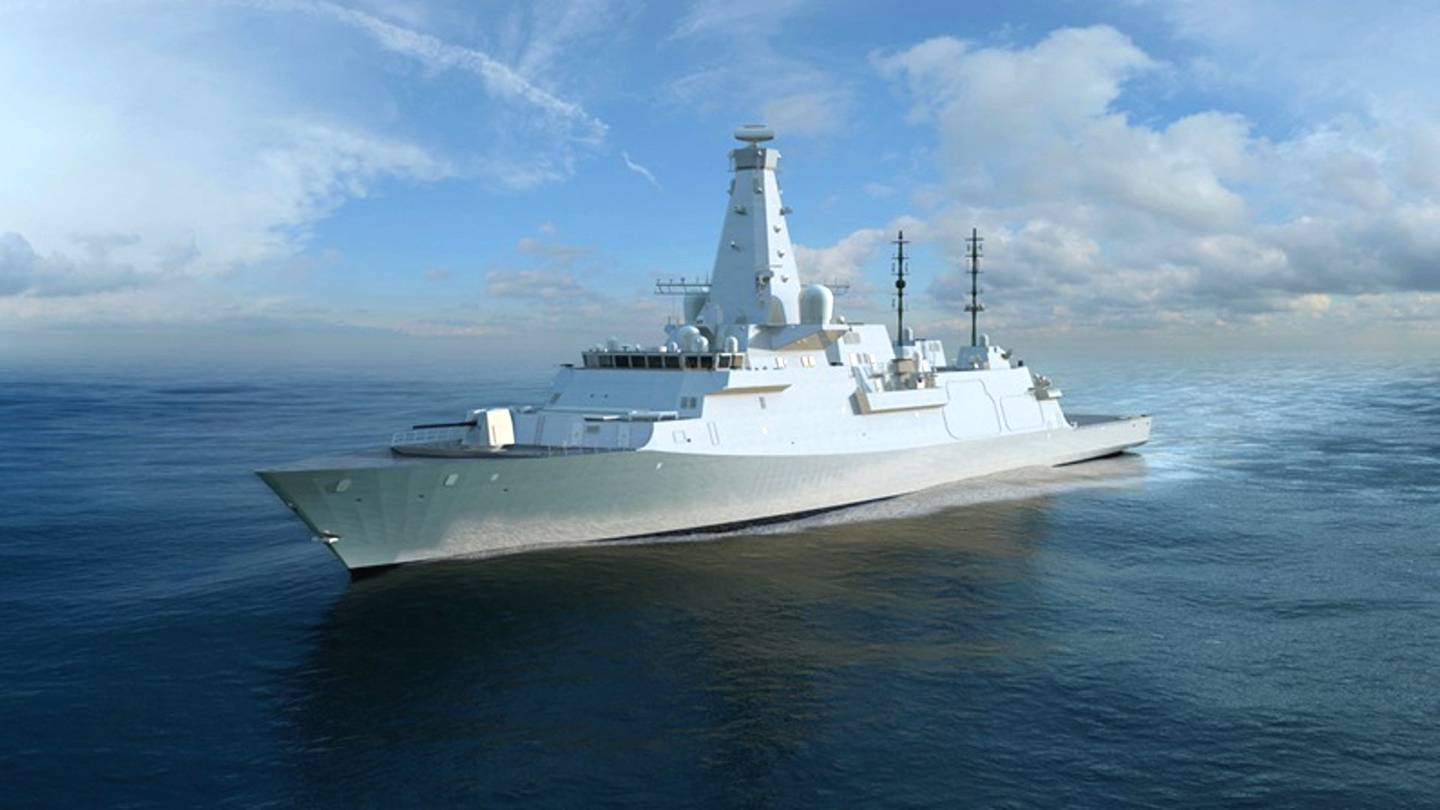
After years of delays and debate, construction of the Royal Navy’s future Type 26 frigates has officially begun at a shipyard in Scotland. The full class of eight ships will provide a number of critically needed capabilities, including acting as additional escorts for the United Kingdom’s up-coming pair of supercarriers. The first of those flattops,
ليس لديك تصريح لمشاهدة الرابط، فضلا قم ب تسجيل الدخول او تسجيل
, is in the middle of her first sea trials in the North Sea."HMS Glasgow and the other seven frigates in this new class will protect our powerful new aircraft carriers and nuclear deterrent, helping keep Britain safe across the world,” Fallon
ليس لديك تصريح لمشاهدة الرابط، فضلا قم ب تسجيل الدخول او تسجيل
. "The Type 26 is a cutting-edge warship that will maintain our naval power with a truly global reach. Designed for a service life of at least 25 years, the Type 26 frigates will form a backbone of the future Royal Navy surface fleet well into the future."Originally known as the
ليس لديك تصريح لمشاهدة الرابط، فضلا قم ب تسجيل الدخول او تسجيل
(GCS), BAE’s frigate will displace approximately 6,900 tons and have a crew of just more than 150. A pair of electric motors, four high speed diesel generators, and a gas turbine will provide onboard electrical power and propel the ship to a maximum speed of over 30 miles per hour over a range of some 7,000 miles.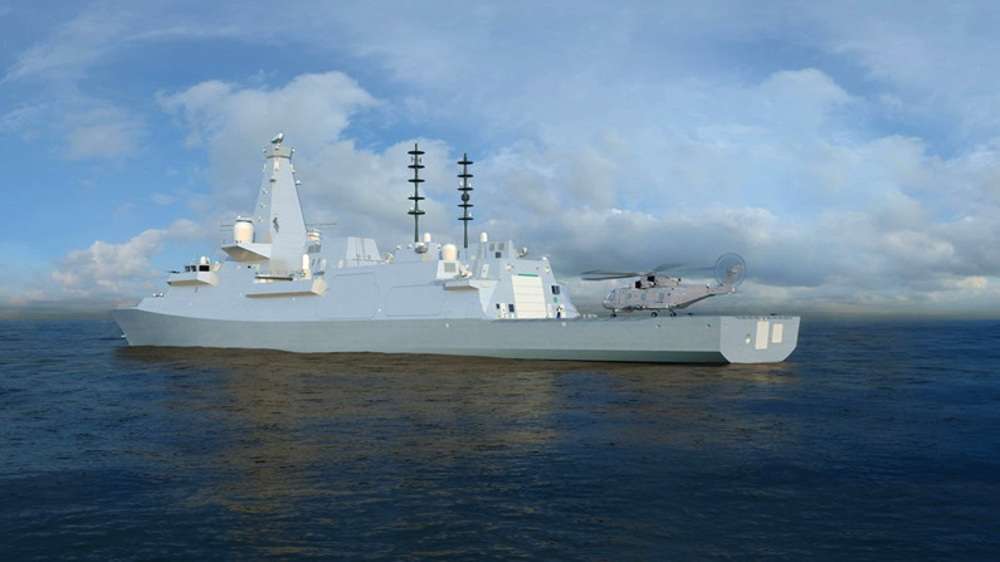
An artists conception of a Type 26 frigate with a Merlin helicopter on its rear helipad.
Intended primarily for anti-submarine warfare, the ships will have both a sonar system in the bow and a built-in towed sonar array, both linked to a central BAE Systems battle management system. An enlarged helipad and attached hangar can accommodate a Wildcat or Merlin helicopter or vertical takeoff capable drones, any of which could carry torpedoes or additional sensors.
In addition, the vessel will have significant air defense and surface warfare capabilities, consisting of 12 vertical launch system (VLS) cells for the Sea Ceptor surface to air missile and another 24 multi-purpose Mk 41 VLS cells. European defense consortium MBDA’s Sea Ceptor missile is a navalized variant of the company’s active radar homing
ليس لديك تصريح لمشاهدة الرابط، فضلا قم ب تسجيل الدخول او تسجيل
(CAMM).Like the U.S. Navy’s RIM-162
ليس لديك تصريح لمشاهدة الرابط، فضلا قم ب تسجيل الدخول او تسجيل
(ESSM), each VLS cell can hold four Sea Ceptors, giving each ship a total of 48 missiles in a relatively compact space. Already in active service, the missile also fit quad-packed into the existing launchers for the older Sea Wolf and the Royal Navy began arming its existing Type 23 frigates with the new weapons in 2016.Raytheon’s Mk 41 VLS can accept a variety of weapons, including the
ليس لديك تصريح لمشاهدة الرابط، فضلا قم ب تسجيل الدخول او تسجيل
Land Attack Missile (TLAM) and various models of the surface-to-air
ليس لديك تصريح لمشاهدة الرابط، فضلا قم ب تسجيل الدخول او تسجيل
. The U.S. Navy has also become interested in the possibility of an over-the-horizon
ليس لديك تصريح لمشاهدة الرابط، فضلا قم ب تسجيل الدخول او تسجيل
that will fit in the cell, most notably Lockheed's stealthy and highly capable
ليس لديك تصريح لمشاهدة الرابط، فضلا قم ب تسجيل الدخول او تسجيل
(LRASM). An official infographic says the inclusion of launchers will give the ships “the widest possible choice of weapons to counter threats as they emerge.”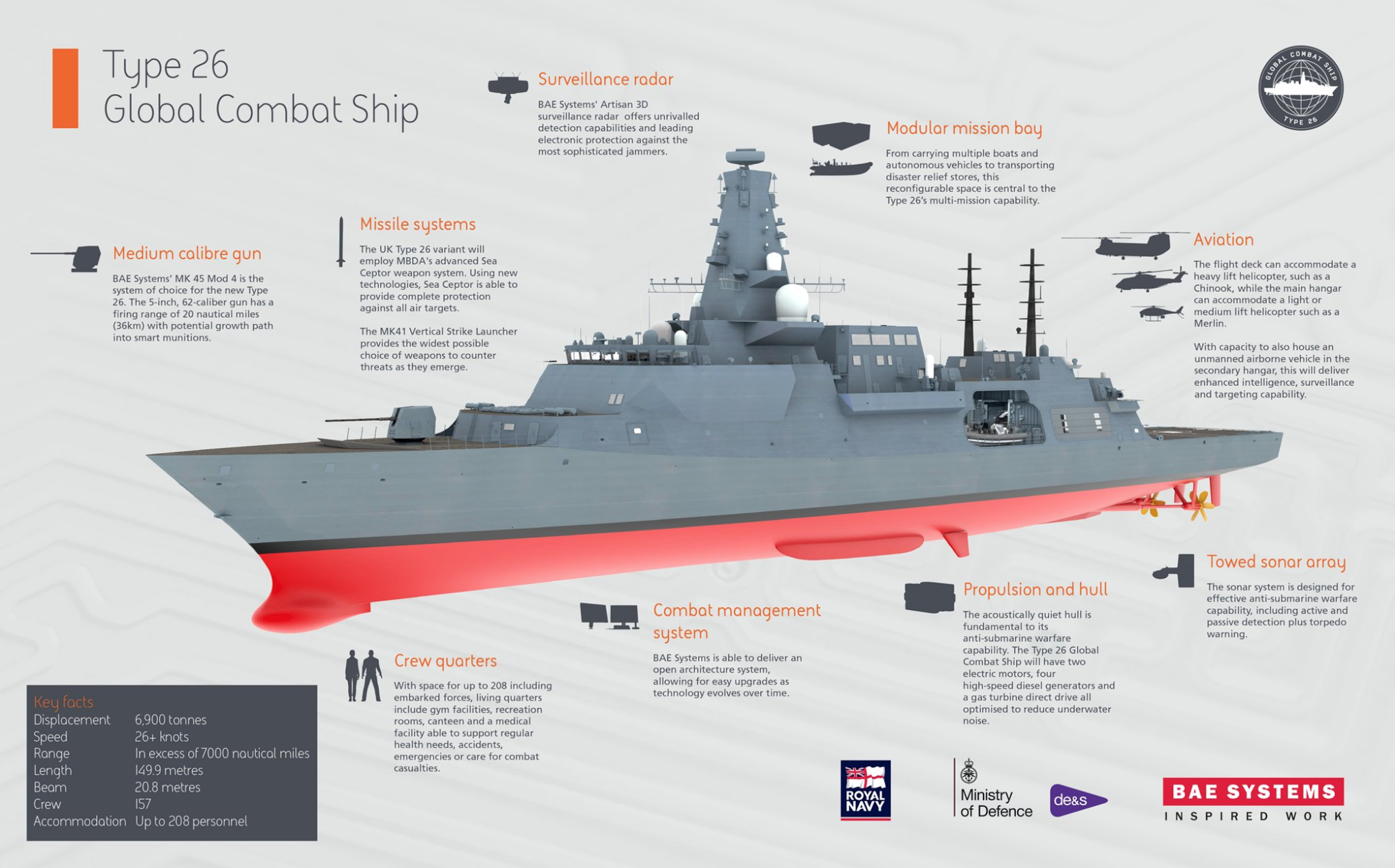
On top of these missiles, each Type 26 frigate will have five-inch gun in a turret on the foredeck with a range of at least 20 miles. Rocket-assisted or guided ammunition, various types of which are already in development, could expand the capabilities of this weapon. In addition, there will be a variety of smaller cannons and machine guns, including the ubiquitous Phalanx CIWS, for close-in self protection against incoming missiles, swarms of small boats, and similar threats.
A BAE Systems Artisan 3D radar will be the City-class’ main sensor to spot enemies on the surface and the air. This is the same type fitted to Queen Elizabeth, which will give the new frigates additional interoperability when working with the larger carriers. Though there is limited information on what other equipment could end up on Glasgow and the other Type 26s, it seems like that additional sensors and electronic warfare measures will be on the final ships.
All of these features would allow the City-class ships to support other, larger surface combatants as part of a carrier battle group or other task force. The ships should be able to operate independently in elevated threat environments, as well. And the Royal Navy is badly in need of additional capable surface combatants
As The War Zone noted in its deep dive into
ليس لديك تصريح لمشاهدة الرابط، فضلا قم ب تسجيل الدخول او تسجيل
, the Royal Navy would need to commit significant numbers of ship to escort the flattop during actual operations. With only six Type 45 Daring-class destroyers and seven Astute- and Trafalgar-class attack submarines, as well as another 13 Type 23 frigates, in total as of 2017, the service could be hard pressed to sortie out a carrier battle group while still conducting other missions, yet alone two battle groups. Typically the U.S. Navy sends its supercarriers out with a guided missile cruiser, three destroyers, and at least one Los Angeles-class attack submarine, in addition to vital logistics ships.The City-class could help potentially reduce the burden on the Darings or other ships, too. Intended to be modular, somewhat like the U.S. Navy’s
ليس لديك تصريح لمشاهدة الرابط، فضلا قم ب تسجيل الدخول او تسجيل
(LCS), each City-class ship will also have reconfigurable “mission bay” to allow it to perform additional tasks. One of these could launch and recover rigid hull inflatable boats for boarding or other specialized missions. Another will reportedly have unspecified drones that can carry disaster relief ashore, according to an official infographic.The
ليس لديك تصريح لمشاهدة الرابط، فضلا قم ب تسجيل الدخول او تسجيل
&
ليس لديك تصريح لمشاهدة الرابط، فضلا قم ب تسجيل الدخول او تسجيل
in 2017 (complete fleet graph)
ليس لديك تصريح لمشاهدة الرابط، فضلا قم ب تسجيل الدخول او تسجيل
Depending on the particular mission, the Glasgow and its sisters could accommodate more than 200 personnel in total, which could conceivably include Royal Marines or special operations forces. While the hangar is too small to store such a helicopter, the ship’s helipad is big enough to accommodate a heavy lift type such as a CH-47 Chinook, which could also support missions on shore.
Also, similar to
ليس لديك تصريح لمشاهدة الرابط، فضلا قم ب تسجيل الدخول او تسجيل
, the planning for what ultimately became the Type 26 began in the late 1990s, but was delayed and slow-rolled due to funding issues and debates over required capabilities and the ship’s exact purpose. The program slogged along until 2015, when the Ministry of Defense finally signed a formal development deal. But Defense Secretary Fallon made clear the following year that there would be no actual production until the design offered actual “
ليس لديك تصريح لمشاهدة الرابط، فضلا قم ب تسجيل الدخول او تسجيل
.”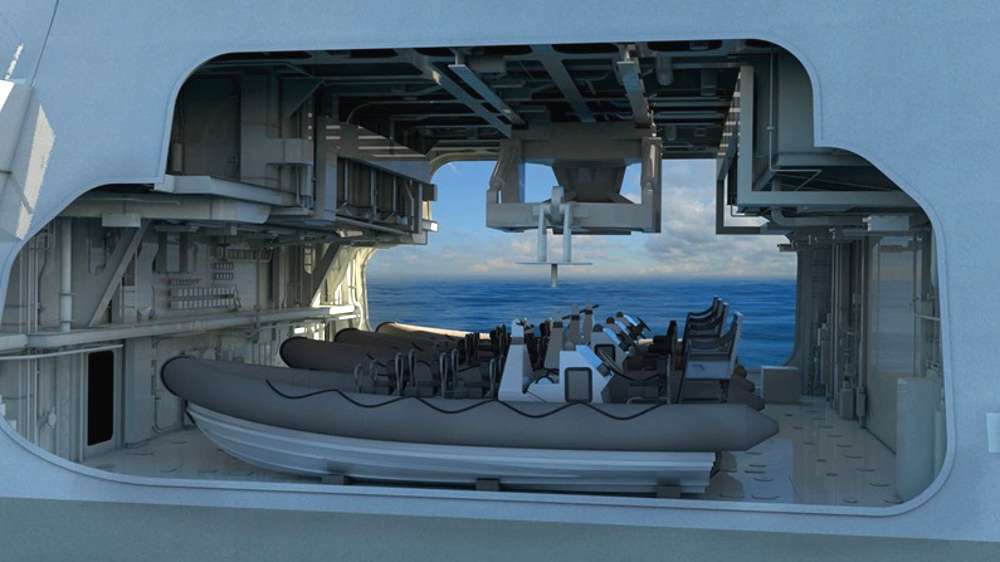
CROWN COPYRIGHT
An artists conception of rigid hull inflatable boats in the Type 26's mission bay.
The overall cost of the project could continue to be a significant factor in both how fast . The U.K. Ministry of Defense's contract only covers the first three City-class ships and carries a price tag of 3.7 billion Pounds. According to Secretary of Defense Fallon, the country's government will have to negotiate another deal for the last five ships and said that might not happen for another six to 10 years.
“As an island nation, we are utterly dependent on the sea for our security and prosperity,” Royal Navy Admiral Sir Philip Jones, First Sea Lord, wrote in a statement. “The City-class confirms the historic bond between the Royal Navy’s fighting ships and our greatest centres of commerce and industry.”
But regardless of any buy in from the public, the Royal Navy could already do with any added flexibility afforded by new ships such as the Type 26s. On July 17, 2017, HMS Richmond, a Type 23 frigate, found itself escorting a
ليس لديك تصريح لمشاهدة الرابط، فضلا قم ب تسجيل الدخول او تسجيل
as they passed through the English Channel on their way to link up with the Russian Navy for drills in the Baltic Sea. Two months earlier, HMS Somerset, another Type 23,
ليس لديك تصريح لمشاهدة الرابط، فضلا قم ب تسجيل الدخول او تسجيل
for one of Russia’s Kilo class submarines, the Krasnodar. And in January 2017, the Royal Navy and Royal Air Force
ليس لديك تصريح لمشاهدة الرابط، فضلا قم ب تسجيل الدخول او تسجيل
the Russian carrier Admiral Kuznetsov and her own escort as they passed by on the way home from operations off Syria.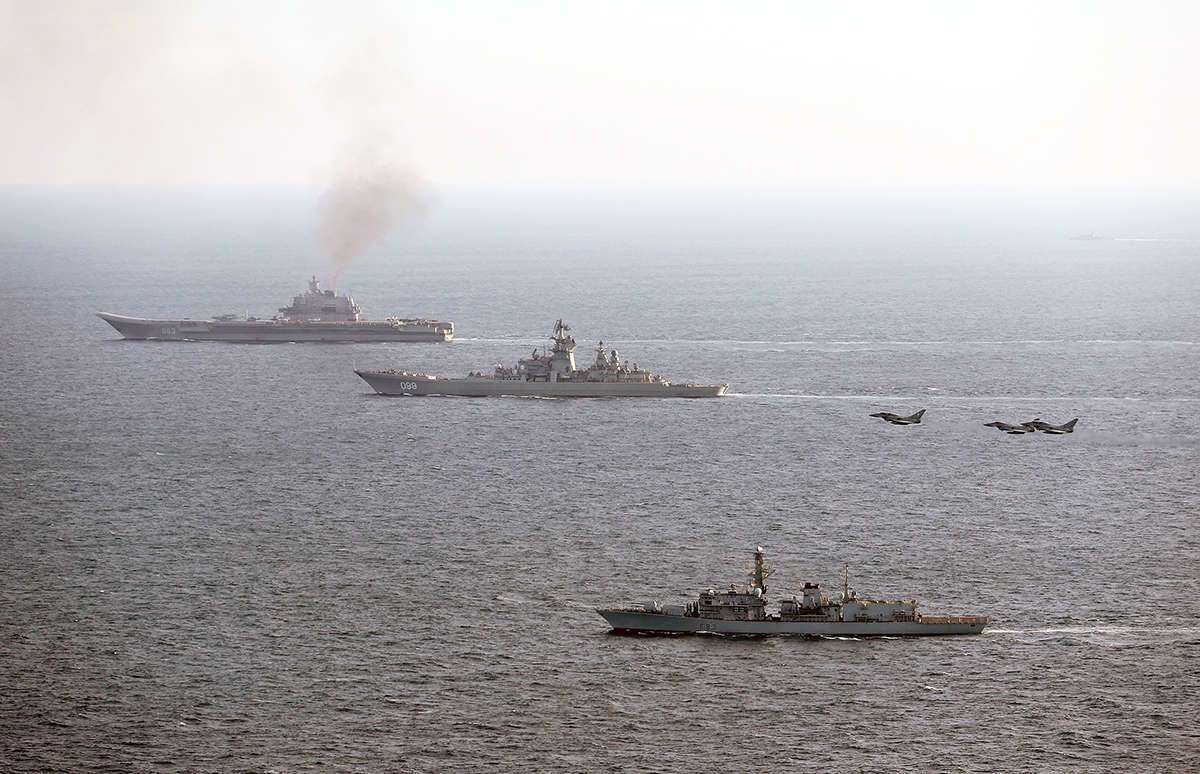
CROWN COPYRIGHT
HMS St. Albans sails alongside the Admiral Kuznetsov and her escort while RAF Typhoon fighter jets fly overhead.
The Baltic Sea in particular has seen increasing air and naval activity since NATO began stepping up exercises in response to the crisis in Ukraine in 2014. Russia responded and the tit-for-tat drills have only increased since then. At present there is already an especially
ليس لديك تصريح لمشاهدة الرابط، فضلا قم ب تسجيل الدخول او تسجيل
in the area ahead of a Russian naval parade in St. Petersburg scheduled for July 30, 2017.The Royal Navy has also sent a Type 45 destroyer,
ليس لديك تصريح لمشاهدة الرابط، فضلا قم ب تسجيل الدخول او تسجيل
, to the Black Sea to join the U.S.-led Sea Breeze 2017 exercise off Ukraine. This is in addition to the service’s various other
ليس لديك تصريح لمشاهدة الرابط، فضلا قم ب تسجيل الدخول او تسجيل
in the North and South Atlantic – including patrolling near the disputed Falkland Islands – the Pacific, and throughout the Middle East. When the first Type 26s enter service they will become an important part of the Royal Navy's continuing global naval presence.It’s not clear when the last of the eight City-class ships might be ready for combat. The Ministry of Defense expects HMS Glasgow and two of her sisters to enter service by the mid-2020s, the same time frame it expects HMS Queen Elizabeth to be operational. In the meantime, the Type 45s and Type 23s will continue to be at the core of the Royal Navy’s surface power in an increasingly busy neighborhood.
ليس لديك تصريح لمشاهدة الرابط، فضلا قم ب تسجيل الدخول او تسجيل
التعديل الأخير:
